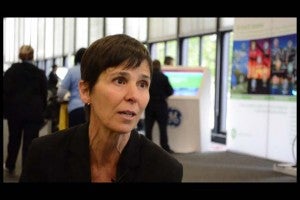The Great Lakes Symposium: Bringing The Smart Grid To The Nation’s Center

View Miriam Horn, director of EDF’s smart grid initiative, speaking with Medill Reports about exciting highlights from the event here.
The first annual Great Lakes Symposium for Smart Grid and the New Energy Economy kicked off last Tuesday, as leaders gathered from across the Midwest and the country to share information on what benefits and challenges a smart grid can deliver to the region. The event was kicked off by Chicago Mayor Rahm Emanuel, promoting energy conservation as the “fifth fuel” (I’d put it first myself). The opening included a moving tribute to Bob Galvin, the pioneer and innovator who created the Galvin Electricity Initiative, one of EDF’s symposium partners.
While the weather didn’t cooperate – it was cold, rainy and, true to Chicago’s nickname, very windy – the panels and events were excellent and informative. The opening keynote, moderated by Joyce Foundation president Ellen Alberding, included representatives from GE and Silver Springs Network discussing how to place the Midwest in a leadership position in the new energy economy. This question is fundamental to why EDF and our partners chose the Midwest for this conference: the region has just the right mix of manufacturing and high tech industries and a strong agricultural base. Perhaps even more importantly, the Midwest needs a smarter, greener grid to transition from its heavy reliance on coal for electricity, to cleaner resources, such as energy efficiency and renewables – and to accommodate the emerging electric vehicle market. And while electricity prices are relatively cheap in this part of the country, they are steadily rising. In his answer to the question, GE’s Luke Clemente noted that a smart grid will enable more renewable energy to be generated in the Midwest, keeping more money in the communities in which the power is generated and contributing to their economic development.
After the keynote, the symposium split into three separate tracks: a Midwest Policy Summit, a Consumer track and an Innovation and Economic Opportunity track. While this allowed attendees to choose the panels that best addressed their particulars interests, it created a bit of a Sophie’s Choice for me, having to decide which panels to attend and which I would have to miss. Fortunately, four of my EDF colleagues were also in attendance, so we were able to cover all the bases. In fact, three of my colleagues, Miriam Horn, Mark Brownstein and Lauren Navarro, each participated on panels, making it clear that EDF is the leading environmental organization working on these important issues to ensure that the smart grid’s promised environmental benefits are in fact delivered.
I opted for a panel on “Leading Practices for Ensuring Consumer Empowerment,” moderated by Pecan Street’s executive director Brewster McCracken. Pecan treet is an innovative smart grid test bed in Austin, Texas, and there’s a lot to be learned from what they’ve done and continue to do there. Brewster shared some fascinating information on “disruptive innovation” as the necessary catalyst for advancing technology. Silver Springs Networks’ Eric Dresselhuys built on this theory by discussing the smart grid movement as one born from disruptive forces and opportunities: first out of the need for reliability, more recently as a reaction to environmental policies and consumer interest and finally to enable emerging resources, such as distributed renewable energy.
I won’t detail every panel I attended, but I’m grateful that staff at the Illinois Institute of Technology were on hand to video all of the events for future reference, which will be housed on the Symposium’s website. Immediately after the symposium, I attended the first ever Perfect Power Seal of ApprovalTM Academy, a program created by the Galvin Electric Initiative to evaluate power system performance. The program is based on a series of well-defined metrics, including reliability, cost, consumer empowerment and efficiency and environmental performance. EDF helped develop the environmental metrics, which assess a broad range of issues, from emissions to land impacts to waste. Roughly thirty grid operators attended the academy, and will receive a certificate for their participation. The Seal of Approval is based on similar principles of perfection as the Six Sigma certification, which was developed by Bob Galvin. It’s a tool that will no doubt prove invaluable.
As a native North Carolinian, I’ve been thrilled to spend some time in Chicago and the Midwest over the past year, working with great partners to bring a smarter, greener grid to the region. The Great Lakes Symposium was an excellent coming out party for EDF, and is only the start of bigger things to come. My heartfelt gratitude goes out to our partners at the Joyce Foundation, the Illinois Institute of Technology, the Citizens Utility Board, the Illinois Science and Technology Coalition, and everyone else who made this event a great success.










